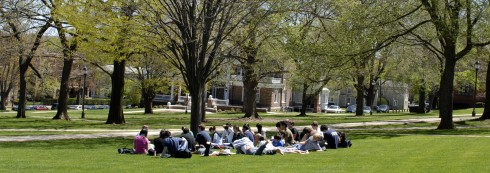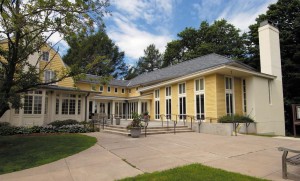
My favorite college student in the world attends Wesleyan University (Michael T. Glen, Class of 2013). Since Michael is a student, last week we received the most recent copy of Wesleyan's emagazine.
The article I found most interesting focused on the trends in admissions. Wesleyan has received 6% more applications this year than last, despite the poor economy. The caliber of the applicant pool also seems incredibly high.
From an analytical standpoint, however, what caught my eye was the disproportionate amount of female applicants to males. I have already put a couple of posts up about the changing demographics on college campuses, so this article continues the trend, I guess.
Why aren't more men applying to college? What will male job prospects be in the future, when education plays such an important role in employment? Does this lack of a strong education background help explain why one out of five American men are currently unemployed?
Mind you, I think this is terrific news for American women. I have a daughter who is a sophomore in high school, and I am very excited about the prospects for her future (OK, so I'm very biased - it is Valentine's Day, after all). But I am puzzled by what the younger members of my gender might be thinking.
I have edited the article, but here's the key points in my opinion:
Applications Up By 6 Percent Over Record Year
Feb. 8, 2010 by Olivia Bartlett Drake

This year, 10,645 seniors from around the world applied to Wesleyan University, an increase of 6 percent from 2009, which was a record year for applications, despite the sour economy.
“Last year we reached an all-time high for applications, up by 22 percent, and this year is 6 percent over that,” says Greg Pyke, senior associate dean of admission.
Of these students, 41 percent are male and 59 percent are female.
The applicant pool contains 362 candidates for the Freeman Asian Scholars program, 860 for early decision admission and 9,423 applications in the regular review process. Two-hundred-and-twenty-nine of these students are alumni sons and daughters.
Compared to 2008 data, this year Wesleyan received 203 more applications from the Midwest, 266 more applications from the South and 619 from the West. Applicants from the Northeast increased by 392 since 2008.

The Office of Admission.
So, why are so many more people applying to Wesleyan? According to a Jan. 29 blog on “Admission and Recognition” by Wesleyan President Michael Roth, it isn’t easy to point to any specific factors with confidence.
“Clearly, we have benefitted from positive press thanks to the great work of our faculty, students, staff and alumni. Our admissions and communications departments have been in high gear making sure that we get the word out about what makes Wesleyan an extraordinary institution,” Roth wrote. “The campus looks great, and investments in our physical plant have had compelling results. We have been emphasizing some of the distinctive aspects of a Wes education, and above all, students and their families have been talking to others about their own experiences.”
Twenty-two percent of the Class of 2014 applicants hail from New England; 20 percent are from New York; 13 percent are from the mid-Atlantic; 7 percent are from the Midwest; 7 percent are from the south; 19 percent are from the west; and 13 percent are from elsewhere in the United States. Twelve percent of the applicants are international.
The applicants come from diverse racial backgrounds. Eleven percent of applicants are Asian or Asian-American, 8 percent are black or African-American, 8 percent are Latino or Hispanic and 1.2 percent, or 125 students are Native American. Sixteen Native Hawaiians also applied to Wesleyan this year.
Of the 10,645 applicants approximately 745 are expected to join the Class of 2014. Sixty-three percent of the applicants, including Freeman Scholars, applied for financial aid.
The median ACT score for the applicant pool is 31 and the median SAT scores are 690 for critical reading and 690 for math. About 25 percent of applicants are sending ACT scores, Meislahn reports.
No comments:
Post a Comment